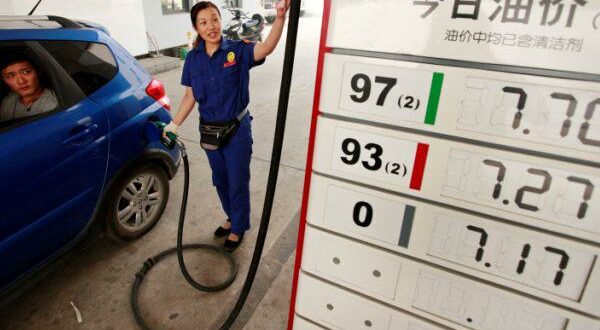The premium traders in Asia are paying for the earliest deliveries of fuel oil is poised to slide from an eight-month high as Europe floods the region with excess supplies and Chinese refinery demand wanes.
Deliveries to Singapore in June will cost an average $1.25 a metric ton more than July contracts in the second half of this month, according to the median estimate of five traders surveyed by Bloomberg this week. The difference was $4.50 on May 1, the most since September 2012, and averaged $2.36 in the first half of the month.
The fading premium shows how Europe’s recession and China’s economic slowdown is hurting the market for a commodity used to power the ships that carry 90 percent of the world’s traded goods. Europe’s exports to Asia are poised to rise to the highest in four months as it struggles to emerge from a recession that’s sapping local demand. At the same time, Chinese refineries that use the fuel to make more valuable gasoline and diesel are cutting purchases as growth slows.
“It doesn’t get more attractive from here,” Miswin Mahesh, a London-based oil analyst at Barclays Plc, said by phone on May 10. “Any time there is a spike in fuel oil, we continue to say fade the rally.”
The swap for 180-centistoke fuel oil for earliest delivery cost $609.75 a ton today, bringing its decline this year to 0.8 percent, according to data from PVM Oil Associates Ltd., a London-based broker. The contract for the fuel in two months cost $608.25, down 1.7 percent this year.
Traders’ Outlook
Four traders surveyed by Bloomberg forecast the premium between the first- and second-month contracts will range from parity to $1.50 in the second half of May. One predicted it would widen to about $7, citing a shortage of the material needed to blend with it to make shipping fuel, or bunker. It was at $1.50 a ton at 2:29 p.m. in Singapore.
Deliveries from Western countries to Asia this month may rise to 4.4 million tons, up from 3.5 million in April, according to data compiled by Bloomberg. That’s the most since January. Shipments from Europe increased to 2.5 million tons, or 57 percent of the total, compared with 1.3 million, or 38 percent in April.
The euro-area economy shrank 0.2 percent in the three months ended March, extending the region’s recession to a record sixth quarter. That followed a 0.6 percent decline in the previous three months, the European Union’s statistics office in Luxembourg said May 15. Brent crude, the North Sea benchmark for more than half of the world’s oil, fell about 6 percent this year, to trade at about $105 today, on concern Europe’s fuel demand will drop.
Oil consumption in European countries that are members of the Organization for Economic Cooperation and Development will fall 2.4 percent to 13.4 million barrels a day this year, according data from the International Energy Agency in Paris.
China’s Teapots
At the same time, fuel oil demand from refineries in eastern China known as teapots that import the oil to make motor fuel has been weakening as the country’s economic growth slows, according to C1 Energy, a Shanghai-based commodity researcher.
“Chinese teapots are not buying at the moment because they need to destock both fuel oil as feedstock and diesel as products amid low run rates,” Sophia Ma, a Guangzhou-based oil analyst at C1 Energy, said by phone. “We are not too optimistic about the outlook.”
Growth in China, the world’s second-largest economy, slowed to 7.7 percent in the first quarter, down from 7.9 percent in the previous three months. That drove its stockpiles of diesel, which fuels trucks and machineries, to the highest in almost a year in February and March, according to data released by Xinhua News Agency’s China Oil, Gas and Petrochemicals newsletter.
China’s teapot refineries cut operating rates to 24 percent on April 18, the lowest in at least three years, according to Oilchem.net, an industry website. The run rate rose to 29.1 percent as of May 2.
Shipping Fuel
Shipping fuel sales in Singapore, the world’s largest vessel-refueling port, fell 1.6 percent to 13.9 million tons in the first four months compared with a year earlier, data from the city-state’s maritime authority show. April sales rose to 3.6 million tons from 3.4 million in March.
Demand from ship owners is falling this month because purchases in April covered their needs, according to Oliver Imaizumi, a senior manager at Petro Summit Pte in Singapore.
“Demand right now is stable, but not that much compared to last month,” Imaizumi said by telephone from Singapore, “Ship owners took the bunker in April so they don’t really need to top up volume in May.”
Singapore Stockpiles
Singapore prices for 380-centistoke fuel oil, the grade used for bunker, fell to $596 a ton on May 15, the lowest in more than five months, according to data compiled by Bloomberg. The price has slid 10 percent from the high of $663.50 in February. It averaged $626.53 this year.
Residual-fuel inventories in Singapore rose for a third week to the highest level in more than five months, according to a unit of the Ministry of Trade and Industry.
Inventories including fuel oil and low-sulfur waxy residue and excluding bitumen gained 2.63 million barrels, or 13 percent, to 22.3 million in the seven days to May 15, International Enterprise Singapore said in an e-mailed statement. That’s the highest since the week ended Dec. 5.
“The market has been strong mainly because of lack of blending stocks,” said Jit Yang Lim, a Singapore-based analyst with KBC Energy Economics. “With a lot of shipments coming in with all the quality fuel oil, that should ease the cracks in the coming month.”
Bloomberg
 Asia Finance News Asia finance news, banking, market analysis, business, Forex, trade, Cryptocurrency as it is happening in Asia. Trusted gateway for Asian financial news.
Asia Finance News Asia finance news, banking, market analysis, business, Forex, trade, Cryptocurrency as it is happening in Asia. Trusted gateway for Asian financial news.





